Day 40 (Fanciful stone)
Day 40
July 31, 2006
Mount Rushmore and Crazy Horse Mountain
Weather wise, today was one of those in between days when we saw some people wearing long pants and sweatshirts while others wore shorts and tank tops. Although the climate here isn’t pure desert, it is semi-arid—enough so that sunshine versus shade still makes a huge difference in how warm you feel. The day dawned with complete overcast—the first we’ve seen like this since one of the days at Yellowstone.
We drove the 19-mile distance to Mount Rushmore National Memorial via the winding roads in and just outside Custer State Park. Frank is now quite comfortable driving on narrow, winding mountain roads with shear drop-offs and no guard rail. At one point, we passed through one of the half-dozen 1-lane tunnels that Custer’s Needles Highway is famous for. Some are only a little more than eight feet wide and ten feet tall.
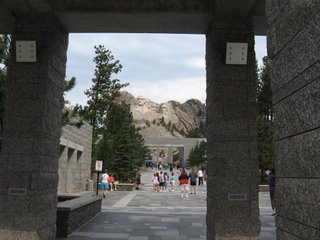 The Rushmore faces, of course, hadn’t changed since Frank was ten, but the infrastructure around it was all grown up. There was a 3-level parking garage to handle the vehicles of the 3+ million people who visit each year, and a new visitor center, theater, cafeteria and gift shop. The pedestrian approach to the mountain was a series of stone arches that you walk through terminating at a new open-air amphitheater that seats 2,500. The posts of the arches bore the flags of all 50 states in the order that they joined the union. There were new lights to illuminate the mountain at night and a boardwalk to carry visitors from the amphitheater to the base of the mountain for an up-close view.
The Rushmore faces, of course, hadn’t changed since Frank was ten, but the infrastructure around it was all grown up. There was a 3-level parking garage to handle the vehicles of the 3+ million people who visit each year, and a new visitor center, theater, cafeteria and gift shop. The pedestrian approach to the mountain was a series of stone arches that you walk through terminating at a new open-air amphitheater that seats 2,500. The posts of the arches bore the flags of all 50 states in the order that they joined the union. There were new lights to illuminate the mountain at night and a boardwalk to carry visitors from the amphitheater to the base of the mountain for an up-close view.
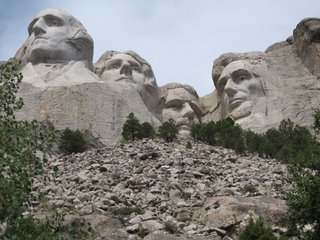 Our general impression was that the faces (each 60 feet tall) looked a bit smaller than we thought they would, and they appeared more 3-D than they typically do in photographs.
Our general impression was that the faces (each 60 feet tall) looked a bit smaller than we thought they would, and they appeared more 3-D than they typically do in photographs.
Mount Rushmore owes its design and construction to a Danish immigrant named Gutzom Borglum, who was so patriotic he named his son “Lincoln.” Gutzom carved Stone Mountain near Atlanta and was invited to South Dakota to carve some faces in stone there as a means of increasing tourism.
We thought Needles Highway was named for the conifers which cover the Black Hills that this WPA-built, “scenic road to nowhere” passes through. In fact, “needles” refers to the thin, Harney granite spires that jut out of the ground, some hundreds of feet tall, throughout the Black Hills.
The original idea was to have Borglum carve some of the needles into likenesses of famous people, not necessarily presidents, but Borglum said the needles were too eroded and wouldn’t stand up to the rigors of carving, so he looked for and found a piece of rock that would be suitable for the busts of four people. It was Borglum who chose the four presidents, Washington, Jefferson, Lincoln and T. Roosevelt. The project cost U. S. taxpayers a total of $1 million and took 14 years to complete. 90% of the stone removed was done so using dynamite. There were many design changes necessitated by imperfections in the stone, including cracks and seams of mica schist that were too soft to carve. In the end, Roosevelt had to be recessed and Jefferson raised in order to fit them in.
 After leaving Mount Rushmore, we drove a section of the Needles Highway to get to Crazy Horse Monument. Several of the 1-lane tunnels were purposefully oriented so that they framed Mount Rushmore as they were passed through—a very dramatic effect.
After leaving Mount Rushmore, we drove a section of the Needles Highway to get to Crazy Horse Monument. Several of the 1-lane tunnels were purposefully oriented so that they framed Mount Rushmore as they were passed through—a very dramatic effect.
Crazy Horse is on a scale that dwarfs Rushmore. Barrowing from Borglum’s ideas, Korczak Ziolkowski and his wife, Ruth, bought a Harney granite mountain near Rushmore and started carving it into the likeness of the famous Lakota Sioux Indian chief, Crazy Horse, depicted as pointing forward while on the back of a galloping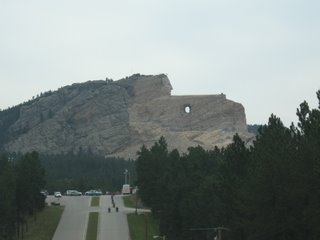 horse. Crazy Horse was born in the Black Hills and was murdered by a soldier who stabbed him in the back while he was bearing a truce flag at Fort Robinson, Nebraska, in 1877. He lived through the ratification and breaching of the now-famous Treaty of 1868, which said, in part, “As long as rivers run and grass grows and trees bear leaves, Paha Sapa—the Black Hills of South Dakota—will forever be the sacred land of the Sioux Indians.”
horse. Crazy Horse was born in the Black Hills and was murdered by a soldier who stabbed him in the back while he was bearing a truce flag at Fort Robinson, Nebraska, in 1877. He lived through the ratification and breaching of the now-famous Treaty of 1868, which said, in part, “As long as rivers run and grass grows and trees bear leaves, Paha Sapa—the Black Hills of South Dakota—will forever be the sacred land of the Sioux Indians.”
The Ziolkowskis started the privately-funded monument in 1949 and for nearly 50 years not much progress was visible aside from a hole through the mountain that visitors were told would one day be the space between his arm and his horse’s neck and mane. Partly because even the Ziolkowskis most ardent supporters were loosing faith, and partly because they were getting up in years and worried that if they didn’t make some progress soon the whole dream might die with them, a big push was made in the 1990s to finish Crazy Horse’s 87-foot-tall face. It is now completed, as is the top of the outstretched arm and one of the feathers atop his head. After witnessing the progress made since he last saw Crazy Horse Monument at age ten, Frank realizes that he probably won’t live to see its completion, but thinks that maybe Elliot and Emily will.
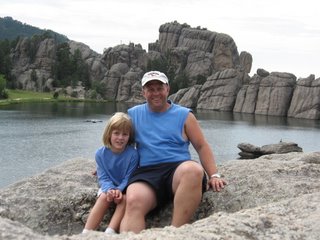 We shopped for food in Custer before returning to the Sylvan Lake Campground. Frank and Emily took a one mile walk around Sylvan Lake on a very nice sharp-stone path, and scrambled on some of the needles that are too numerous to count in and around the lake. They both agreed that this was some of the best rock for scrambling they had experienced anywhere, and could have spent days climbing there.
We shopped for food in Custer before returning to the Sylvan Lake Campground. Frank and Emily took a one mile walk around Sylvan Lake on a very nice sharp-stone path, and scrambled on some of the needles that are too numerous to count in and around the lake. They both agreed that this was some of the best rock for scrambling they had experienced anywhere, and could have spent days climbing there.
We were very impressed with Custer State Park. It was the nicest state park we’ve been to anywhere. It really is of a National Park caliber. We checked out all of the campgrounds within the park and Sylvan Lake is the best and most beautiful. Put a walk around Sylvan Lake at Custer State Park on the list of things to do.
After dinner we returned to Mount Rushmore to take in the nightly performance staged in the amphitheater. It consisted of a lecture given by a Native American ranger who compared each of the four presidents to a famous Indian, a movie about American ideals, the lighting of the faces with huge spotlights, and the singing in unison by the crowd of the National Anthem. Then, all of the veterans in the audience were invited onto the stage to help “retire the colors” for the day. It was a pretty patriotic experience.
July 31, 2006
Mount Rushmore and Crazy Horse Mountain
Weather wise, today was one of those in between days when we saw some people wearing long pants and sweatshirts while others wore shorts and tank tops. Although the climate here isn’t pure desert, it is semi-arid—enough so that sunshine versus shade still makes a huge difference in how warm you feel. The day dawned with complete overcast—the first we’ve seen like this since one of the days at Yellowstone.
We drove the 19-mile distance to Mount Rushmore National Memorial via the winding roads in and just outside Custer State Park. Frank is now quite comfortable driving on narrow, winding mountain roads with shear drop-offs and no guard rail. At one point, we passed through one of the half-dozen 1-lane tunnels that Custer’s Needles Highway is famous for. Some are only a little more than eight feet wide and ten feet tall.
 The Rushmore faces, of course, hadn’t changed since Frank was ten, but the infrastructure around it was all grown up. There was a 3-level parking garage to handle the vehicles of the 3+ million people who visit each year, and a new visitor center, theater, cafeteria and gift shop. The pedestrian approach to the mountain was a series of stone arches that you walk through terminating at a new open-air amphitheater that seats 2,500. The posts of the arches bore the flags of all 50 states in the order that they joined the union. There were new lights to illuminate the mountain at night and a boardwalk to carry visitors from the amphitheater to the base of the mountain for an up-close view.
The Rushmore faces, of course, hadn’t changed since Frank was ten, but the infrastructure around it was all grown up. There was a 3-level parking garage to handle the vehicles of the 3+ million people who visit each year, and a new visitor center, theater, cafeteria and gift shop. The pedestrian approach to the mountain was a series of stone arches that you walk through terminating at a new open-air amphitheater that seats 2,500. The posts of the arches bore the flags of all 50 states in the order that they joined the union. There were new lights to illuminate the mountain at night and a boardwalk to carry visitors from the amphitheater to the base of the mountain for an up-close view. Our general impression was that the faces (each 60 feet tall) looked a bit smaller than we thought they would, and they appeared more 3-D than they typically do in photographs.
Our general impression was that the faces (each 60 feet tall) looked a bit smaller than we thought they would, and they appeared more 3-D than they typically do in photographs.Mount Rushmore owes its design and construction to a Danish immigrant named Gutzom Borglum, who was so patriotic he named his son “Lincoln.” Gutzom carved Stone Mountain near Atlanta and was invited to South Dakota to carve some faces in stone there as a means of increasing tourism.
We thought Needles Highway was named for the conifers which cover the Black Hills that this WPA-built, “scenic road to nowhere” passes through. In fact, “needles” refers to the thin, Harney granite spires that jut out of the ground, some hundreds of feet tall, throughout the Black Hills.
The original idea was to have Borglum carve some of the needles into likenesses of famous people, not necessarily presidents, but Borglum said the needles were too eroded and wouldn’t stand up to the rigors of carving, so he looked for and found a piece of rock that would be suitable for the busts of four people. It was Borglum who chose the four presidents, Washington, Jefferson, Lincoln and T. Roosevelt. The project cost U. S. taxpayers a total of $1 million and took 14 years to complete. 90% of the stone removed was done so using dynamite. There were many design changes necessitated by imperfections in the stone, including cracks and seams of mica schist that were too soft to carve. In the end, Roosevelt had to be recessed and Jefferson raised in order to fit them in.
 After leaving Mount Rushmore, we drove a section of the Needles Highway to get to Crazy Horse Monument. Several of the 1-lane tunnels were purposefully oriented so that they framed Mount Rushmore as they were passed through—a very dramatic effect.
After leaving Mount Rushmore, we drove a section of the Needles Highway to get to Crazy Horse Monument. Several of the 1-lane tunnels were purposefully oriented so that they framed Mount Rushmore as they were passed through—a very dramatic effect.Crazy Horse is on a scale that dwarfs Rushmore. Barrowing from Borglum’s ideas, Korczak Ziolkowski and his wife, Ruth, bought a Harney granite mountain near Rushmore and started carving it into the likeness of the famous Lakota Sioux Indian chief, Crazy Horse, depicted as pointing forward while on the back of a galloping
 horse. Crazy Horse was born in the Black Hills and was murdered by a soldier who stabbed him in the back while he was bearing a truce flag at Fort Robinson, Nebraska, in 1877. He lived through the ratification and breaching of the now-famous Treaty of 1868, which said, in part, “As long as rivers run and grass grows and trees bear leaves, Paha Sapa—the Black Hills of South Dakota—will forever be the sacred land of the Sioux Indians.”
horse. Crazy Horse was born in the Black Hills and was murdered by a soldier who stabbed him in the back while he was bearing a truce flag at Fort Robinson, Nebraska, in 1877. He lived through the ratification and breaching of the now-famous Treaty of 1868, which said, in part, “As long as rivers run and grass grows and trees bear leaves, Paha Sapa—the Black Hills of South Dakota—will forever be the sacred land of the Sioux Indians.”The Ziolkowskis started the privately-funded monument in 1949 and for nearly 50 years not much progress was visible aside from a hole through the mountain that visitors were told would one day be the space between his arm and his horse’s neck and mane. Partly because even the Ziolkowskis most ardent supporters were loosing faith, and partly because they were getting up in years and worried that if they didn’t make some progress soon the whole dream might die with them, a big push was made in the 1990s to finish Crazy Horse’s 87-foot-tall face. It is now completed, as is the top of the outstretched arm and one of the feathers atop his head. After witnessing the progress made since he last saw Crazy Horse Monument at age ten, Frank realizes that he probably won’t live to see its completion, but thinks that maybe Elliot and Emily will.
 We shopped for food in Custer before returning to the Sylvan Lake Campground. Frank and Emily took a one mile walk around Sylvan Lake on a very nice sharp-stone path, and scrambled on some of the needles that are too numerous to count in and around the lake. They both agreed that this was some of the best rock for scrambling they had experienced anywhere, and could have spent days climbing there.
We shopped for food in Custer before returning to the Sylvan Lake Campground. Frank and Emily took a one mile walk around Sylvan Lake on a very nice sharp-stone path, and scrambled on some of the needles that are too numerous to count in and around the lake. They both agreed that this was some of the best rock for scrambling they had experienced anywhere, and could have spent days climbing there.We were very impressed with Custer State Park. It was the nicest state park we’ve been to anywhere. It really is of a National Park caliber. We checked out all of the campgrounds within the park and Sylvan Lake is the best and most beautiful. Put a walk around Sylvan Lake at Custer State Park on the list of things to do.
After dinner we returned to Mount Rushmore to take in the nightly performance staged in the amphitheater. It consisted of a lecture given by a Native American ranger who compared each of the four presidents to a famous Indian, a movie about American ideals, the lighting of the faces with huge spotlights, and the singing in unison by the crowd of the National Anthem. Then, all of the veterans in the audience were invited onto the stage to help “retire the colors” for the day. It was a pretty patriotic experience.
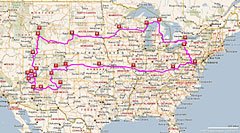


0 Comments:
Post a Comment
<< Home